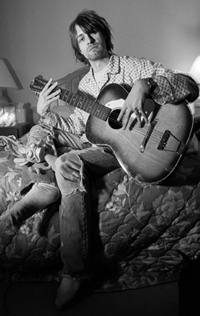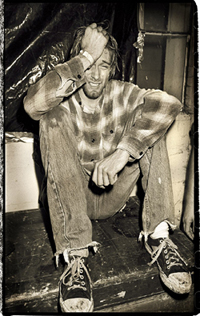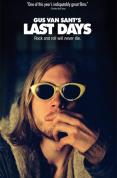Seen and Heard Photography and Film Review
Kurt Cobain: Photographed and Fictionalized:
Proud Galleries, 34 John Adam Street,
London WC2 (until 17th November 2005) and Gus Van
Santís Last Days (2005),
reviewed by Marc Bridle

Proud
Galleries exhibition of photographs by Charles Peterson and
Ian Tilton visualizes one of the seminal icons of late twentieth
century music. Subtitled Nirvana: with the lights out (taken from the 2004 release of a 3-disc
set of largely unreleased recordings) the photographs capture
the cathartic anger of youth, rebellion and isolationism. None
of the images are new, but they have been curated in such a
way that they come to give narrative symbolism to the comparatively
short life of both band and lead singer.
Great photography can have an almost biographical
aura around it and some of these photographs achieve that effect.
Cobainís well-known addiction to cocaine and heroin, something
which a medical misdiagnosis in his youth almost certainly made
inevitable, brings with it a juxtaposition of mental anguish
and photographic nakedness. Ian Tiltonís Nirvana, Seattle Motorsportís
garage from 1990, for example, has an almost unrelenting anger
which pervades it. Charles Petersonís Nirvana, Annex Theater,
Seattle from 1989 shows a crouched Cobain, suggestive of the
release that position gives for abdominal pain caused by heroin
addiction. The psychological or somatic disposition towards
insomnia, nausea and hallucination is captured with almost visual
force in many of these photographs: the blurred psychedelia
of Nirvana, COCA, Seattle, 1989 almost captures all three, whereas
Kurt Cobain, New Yearís Eve 1993, is a picture of unsettled
isolationism, something much more obvious to the eye than in
Ian Tiltonís Kurt Cobain, September, Seattle 1990 where Cobainís
loneliness is less haunted than that which emerges from the
later pictures suggests.

Nirvanaís own blend of music, with its
masterful, yet searing repetition, made them much more hardcore
punk than their imitators, and yet its aesthetic was also a
refreshingly melodic one. Photographs such as Charles Petersonís
Nirvana Stage, Seattle Center Coliseum, 1992 revel in the wake
of post-concert destruction: the upturned drum kits, the empty
bottles, the litter trodden into the stage all convey conventional
punk angst. And yet the same photographerís Kurt Cobain, Seattle
Center Coliseum, 1992 gives an almost mirror image of the same
concert: here we have an illusionary stick-thin Cobain (in real
life he was anything but this) looking out into a dark auditorium,
his isolation palpable to the eye.
One of the great virtues of modern music
photography is that it captures a moment of completely unpremeditated
action. Many of these photographs have a raw, spontaneous energy
to them Ė even the ones which show Cobain alone and unsettled.
Pictured in the surroundings in which they were intended to
be taken, many of these images are given context (something
which could not always be said of Dennis Morrisí celebrated
portraits of the Sex Pistols which often seemed to be visualized
outside of their intended setting).
None of these photographs give us a sense
of discovery into the last days or hours of Kurt Cobain. Gus
Van Santís Last Days,
however, tries to do this, although the film itself is heavily
fictionalized. The central figure Ė Blake, a brilliant but troubled
musician Ė is modelled on Kurt Cobain in almost every way: from
the characteristic grunge clothing of torn jeans and Converse
sneakers to the physical depiction of Blake as an unkempt blonde
haired depressive the allusion to Cobain is difficult to ignore.
Van Santís film, though, is meditative, a study in narcoleptic
drug dependency that seems almost anti-biopic. This is certainly
a much more aggressive look into the mind of a musician than
say Nick Broomfieldís Kurt
and Courtney, a film that although both revealing and full
of insights ends up being a documentary about the freedom of
speech.

Van Santís film (unlike Broomfieldís) offers no easy
answers or conspiracy theories Ė indeed it offers none at all.
Even the music of Nirvana is deliberately taken to the periphery
so as not to chain the film to a biopic reality. Michael Pittís
central performance as Blake is almost overwhelming in its articulation
of mood: dialogue is minimalized throughout, but when Pitt speaks,
if at all, it is frequently mumbled, and largely incomprehensible.
He shuffles around as if in a coma, and actions speak volumes
in Van Santís illustrational film: the very fact that Van Sant
shows mental confusion through action rather than words (Blake,
for example, puts a box of cornflakes in the fridge rather than
the milk) lends the film a stimulating metaphysicalness that
surmounts the usual hysteria of film biopics.
The poetry which Pitt brings to his central
performance is mirrored in Van Santís equally poetic cinematography.
Shots are often cued from a distance rather than close up, and
Van Santís careful use of filming from different angles gives
the film a repetitiveness that comes to symbolize the central
characterís confusion. And yet, despite the heavy fictionalization
of the final hours, so much else about the film deals with universal
truths: the loneliness of success is viscerally placed here,
as is personal insecurity. Friendships are now borne of money
and favours; Blake, like Cobain, does become a fugitive with
suicide becoming the only release.
Seeing Gus Van Santís film so soon after
the opening night of Nirvana:
with the lights out leaves one with a sense of unease: on
the one hand, we have the life-affirming spontaneity of music
making as seen through static visual art; on the other, a sense
of disillusion and destruction as witnessed through the art
of cinematography which seeks to place the context of that music
into the suicidal rebirth of the inspiration which made it.
Marc Bridle
Proud Galleries website
is at www.proud.co.uk.
Gus Van Santís Last Days
is available on DVD from PlayUSA.com
priced £13.99 (Region 1 only).
†





